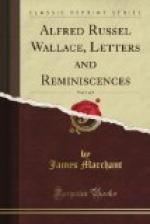In Part I., Section I., many passages occur which clearly reveal his awakening to the study of nature. A chance remark overheard in conversation in the quiet street of Hertford touched the hidden spring of interest in a subject which was to become the one great purpose of his life. Then his enthusiastic yielding to the simple and natural attraction which flowers and trees have always exerted upon the sympathetic observer led step by step to the study of groups and families, until, on his second sojourn at Neath, and about a year before his journey to South America with H.W. Bates, we find him deliberately pondering over the problem which many years later he described by saying that he “had in fact been bitten by the passion for species and their description.”
In a letter to Bates dated November 9th, 1847, he concludes by asking, “Have you read ‘Vestiges of the Natural History of Creation,’ or is it out of your line?” and in the next (dated December 28th), in reply to one from his friend, he continues, “I have a rather more favourable opinion of the ‘Vestiges’ than you appear to have, I do not consider it a hasty generalisation, but rather an ingenious hypothesis strongly supported by some striking facts and analogies, but which remains to be proved by more facts and the additional light which more research may throw upon the problem.... It furnishes a subject for every observer of nature to attend to; every fact,” he observes, “will make either for or against it, and it thus serves both as an incitement to the collection of facts, and an object to which they can be applied when collected. Many eminent writers support the theory of the progressive development of animals and plants. There is a very philosophical work bearing directly on the question—Lawrence’s ’Lectures on Man’.... The great object of these ‘Lectures’ is to illustrate the different races of mankind, and the manner in which they probably originated, and he arrives at the conclusion (as also does Prichard in his work on the ‘Physical History of Man’) that the varieties of the human race have not been produced by any external causes, but are due to the development of certain distinctive peculiarities in some individuals which have thereafter become propagated through an entire race. Now, I should say that a permanent peculiarity not produced by external causes is a characteristic of ‘species’ and not of mere ‘variety,’ and thus, if the theory of the ‘Vestiges’ is accepted, the Negro, the Red Indian, and the European are distinct species of the genus Homo.
“An animal which differs from another by some decided and permanent character, however slight, which difference is undiminished by propagation and unchanged by climate and external circumstances, is universally held to be a distinct species; while one which is not regularly transmitted so as to form a distinct race, but is occasionally reproduced from the parent stock (like albinoes), is generally, if the difference is not very considerable, classed as a variety. But I would class both these as distinct species, and I would only consider those to be varieties whose differences are produced by external causes, and which, therefore, are not propagated as distinct races.”




